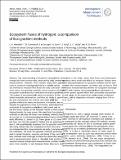| dc.contributor.author | Meredith, Laura Kelsey | |
| dc.contributor.author | Commane, R. | |
| dc.contributor.author | Munger, J. W. | |
| dc.contributor.author | Dunn, A. | |
| dc.contributor.author | Tang, J. | |
| dc.contributor.author | Wofsy, S. C. | |
| dc.contributor.author | Prinn, Ronald G. | |
| dc.date.accessioned | 2014-10-17T14:09:07Z | |
| dc.date.available | 2014-10-17T14:09:07Z | |
| dc.date.issued | 2014-09 | |
| dc.date.submitted | 2014-07 | |
| dc.identifier.issn | 1867-8548 | |
| dc.identifier.uri | http://hdl.handle.net/1721.1/90961 | |
| dc.description.abstract | Our understanding of biosphere–atmosphere exchange has been considerably enhanced by eddy covariance measurements. However, there remain many trace gases, such as molecular hydrogen (H[subscript 2]), that lack suitable analytical methods to measure their fluxes by eddy covariance. In such cases, flux-gradient methods can be used to calculate ecosystem-scale fluxes from vertical concentration gradients. The budget of atmospheric H[subscript 2] is poorly constrained by the limited available observations, and thus the ability to quantify and characterize the sources and sinks of H[subscript 2] by flux-gradient methods in various ecosystems is important. We developed an approach to make nonintrusive, automated measurements of ecosystem-scale H2 fluxes both above and below the forest canopy at the Harvard Forest in Petersham, Massachusetts, for over a year. We used three flux-gradient methods to calculate the fluxes: two similarity methods that do not rely on a micrometeorological determination of the eddy diffusivity, K, based on (1) trace gases or (2) sensible heat, and one flux-gradient method that (3) parameterizes K. We quantitatively assessed the flux-gradient methods using CO[subscript 2] and H[subscript 2]O by comparison to their simultaneous independent flux measurements via eddy covariance and soil chambers. All three flux-gradient methods performed well in certain locations, seasons, and times of day, and the best methods were trace gas similarity for above the canopy and K parameterization below it. Sensible heat similarity required several independent measurements, and the results were more variable, in part because those data were only available in the winter, when heat fluxes and temperature gradients were small and difficult to measure. Biases were often observed between flux-gradient methods and the independent flux measurements, and there was at least a 26% difference in nocturnal eddy-derived net ecosystem exchange (NEE) and chamber measurements. H[subscript 2] fluxes calculated in a summer period agreed within their uncertainty and pointed to soil uptake as the main driver of H[subscript 2] exchange at Harvard Forest, with H[subscript 2] deposition velocities ranging from 0.04 to 0.10 cm s[superscript −1]. | en_US |
| dc.description.sponsorship | National Science Foundation (U.S.) (NSF Graduate Research Fellowship) | en_US |
| dc.description.sponsorship | United States. National Aeronautics and Space Administration (Advanced Global Atmospheric Gases Experiment (AGAGE)) | en_US |
| dc.description.sponsorship | Massachusetts Institute of Technology. Joint Program on the Science & Policy of Global Change | en_US |
| dc.description.sponsorship | Martin Family Society of Fellows for Sustainability | en_US |
| dc.description.sponsorship | Massachusetts Institute of Technology (Ally of Nature Research Fund) | en_US |
| dc.description.sponsorship | Massachusetts Institute of Technology (William Otis Crosby Lectureship) | en_US |
| dc.description.sponsorship | Massachusetts Institute of Technology (Warren Klein Fund) | en_US |
| dc.language.iso | en_US | |
| dc.publisher | Copernicus GmbH on behalf of the European Geosciences Union | en_US |
| dc.relation.isversionof | http://dx.doi.org/10.5194/amt-7-2787-2014 | en_US |
| dc.rights | Creative Commons Attribution | en_US |
| dc.rights.uri | http://creativecommons.org/licenses/by/3.0/ | en_US |
| dc.source | Copernicus Publications | en_US |
| dc.title | Ecosystem fluxes of hydrogen: a comparison of flux-gradient methods | en_US |
| dc.type | Article | en_US |
| dc.identifier.citation | Meredith, L. K., R. Commane, J. W. Munger, A. Dunn, J. Tang, S. C. Wofsy, and R. G. Prinn. “Ecosystem Fluxes of Hydrogen: a Comparison of Flux-Gradient Methods.” Atmos. Meas. Tech. 7, no. 9 (2014): 2787–2805. | en_US |
| dc.contributor.department | Massachusetts Institute of Technology. Center for Global Change Science | en_US |
| dc.contributor.mitauthor | Meredith, Laura Kelsey | en_US |
| dc.contributor.mitauthor | Prinn, Ronald G. | en_US |
| dc.relation.journal | Atmospheric Measurement Techniques | en_US |
| dc.eprint.version | Final published version | en_US |
| dc.type.uri | http://purl.org/eprint/type/JournalArticle | en_US |
| eprint.status | http://purl.org/eprint/status/PeerReviewed | en_US |
| dspace.orderedauthors | Meredith, L. K.; Commane, R.; Munger, J. W.; Dunn, A.; Tang, J.; Wofsy, S. C.; Prinn, R. G. | en_US |
| dc.identifier.orcid | https://orcid.org/0000-0001-5925-3801 | |
| mit.license | PUBLISHER_CC | en_US |
| mit.metadata.status | Complete | |
